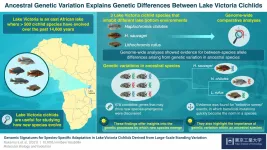"Veterinary medicine may require us to treat the patient, but we are unable to improve pet patient outcomes without human client consent and trust. Communication is an essential component of veterinary practice," said Ryane Englar, an associate professor and the director of veterinary skills development for the college. "As an anecdotal example, vets and breeders don't always get along, but there was no research on these subjects. I wondered, what do the groups want and need? If they are aligned in any way, how can we work with one another better?"
Englar's most recent study, published in the Journal of the American Veterinary Medical Association, explores biases and communication between vets and breeders. She found that dog and cat breeders often feel that veterinarians lack training and knowledge about birth and breeding. At the same time, vets may not acknowledge breeders' expertise on the subject, and may disapprove of breeding and make assumptions about breeders.
Englar hopes that addressing such biases will help people take better care of animals and each other. She proposes solutions to the tension between pet owners, breeders and vets in her research and in her classes, which focus not only on veterinary skills but on communication skills such as genuine listening, putting judgments on hold, being aware of assumptions and asking questions.
During National Pet Month, UArizona News spoke with Englar about her latest research and her philosophy on animal care and human communication.
Q: Why did you decide to study veterinary medicine communication, and why is it so important?
A: When I attended vet school, classes on communication and professionalism were not required. Historically, it's seen as a soft skill, and something that cannot be taught. In class, it was a sink-or-swim mentality; we were thrown into clinics and expected to just take (medical) history, talk to people, explain diagnoses. I did feel more equipped than peers, though. My mom is a hospice social worker, and my father is a high school teacher; I got my communications training from them. My mom taught me about death and dying and grief and bereavement, so I was well suited to end-of-life talks. But then, communication skills started to get flagged as something that was lacking in the field. It's now seen as a teachable skill, like suturing. Personally, I went from never being taught communication, to asking clients what they want and need to improve communication. At that point, I was proud of the progress, but this research has taught me that I'm still generalizing and approaching some clients with preconceived notions, and that hinders communication and care.
Q: What do pet owners want from their vets when it comes to communication?
A: We teach TONERR to students, which is a method we pieced together from a separate study. It stands for transparency, open-ended questions, nonverbal cues, empathy, reflective listening and unconditional positive regard.
For example, we found that clients want vets to be honest about what they don't know. They expect vets to say, "This is how I can find the information for you." And they expect transparency about diagnoses and prognoses. Don't skirt around things. Clients want to be seen as individuals worthy of respect. We teach students to try and leave their judgment at the door. For example, if a dog owner gives their pet painkillers for a high fever - which you shouldn't do - we'd hope the vet would realize that they likely did it from a good place; they just lacked the knowledge. We'd hope the vet would say, "I can see why you did what you did, but you're here now, so let's focus on that."
Q: As a vet, how did you feel about your latest research findings about communication between vets and breeders?
A: This was one of the most eye-opening studies I've ever done. It taught me a lot about myself. When I read comments from breeders (who participated in the study), some made me feel defensive, but then there was so much that resonated. I hope it helps people think about bridging the divide. If we can understand each other, there's almost perfect alignment from what all parties want and expect. When I surveyed (participants) for solutions, both sides suggested the same things. We just need to get past these biases and actually hear each other.
Here are some examples: Most vets have never seen any dog or cat give birth. Our (pet patient) population is almost all spayed or neutered. It's the assumption that good owners will spay or neuter their pets, and when animals are born, they're born at home and we don't see them until they're eight weeks old. So, when we see an animal that is not spayed or neutered, we wonder why that owner hasn't fixed their pet yet. That makes us have preconceived notions. The reality is that, as vets, we want to be respected for our knowledge and experience; yet, breeders feel they are not being acknowledged for their own knowledge or experience. They've seen hundreds of births, while we've seen close to zero. There needs to be understanding that we each bring different skills to the table.
Q: How has your research affected what you teach in the classroom?
A: Here, at the University of Arizona College of Veterinary Medicine, it is important to me that communication skills have equal consideration in the classroom. My colleague Teresa Graham Brett (the college's associate dean of diversity and inclusion) and I script fictional cases for students. We ask students to consider their expectations before an encounter and compare it to how the encounter actually unfolded, as well as their assumptions about the case, the patient or the client, based on limited details provided upfront. We teach our students that assumptions are normal; it is how we process the world around us and make sense of it. However, we also need students to be aware of how preconceived notions influence their reactions and responses to clinical scenarios, patients and clients. To be successful at relationship-centered care, students need to learn how to move from reaction to response.
Beyond communication, Teresa and I want students to learn to develop their own professional identity, to tactfully practice bad news delivery with clients, to manage the financial and business side of clinical practice and to be resilient in the face of burnout. They might have to euthanize an animal, but we need to teach them how to process their emotions and emotionally reset so they can continue to face appointments after a poor patient outcome.
It's a long journey, but our hope is that we graduate day-one ready students with critical thinking skills, who are able to work with each other and support staff, who are better able to work with clients and really understand themselves in the same way I was open to learning that I have areas to work on after my breeder survey. Medicine is life-long learning and we're all learning together. None of us are perfect, but it's about being a person, first and foremost.
INFORMATION:


